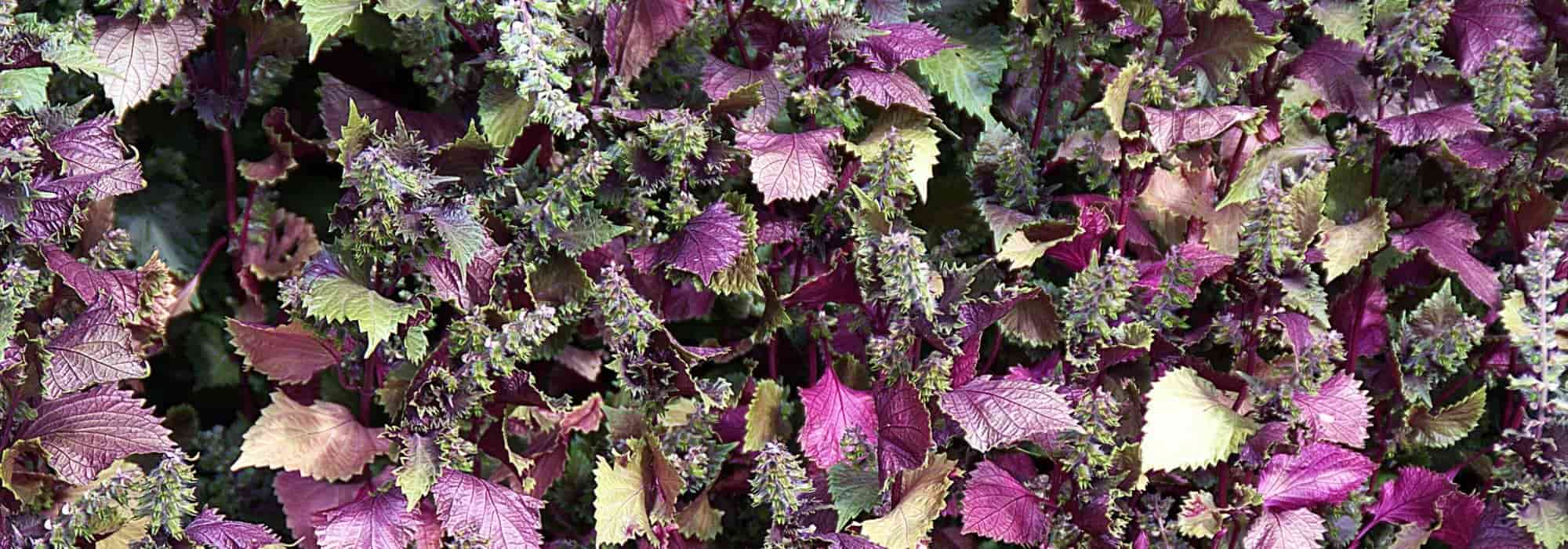
Perilla (shiso): sowing, care, and harvest
Contents
Perilla in a nutshell
- Perilla is both a culinary, ornamental, medicinal, and aromatic plant
- Very frost-sensitive, it is grown as an annual here
- Its green to purple foliage is highly aromatic and has a unique flavour that oscillates between lemon balm, star anise, cinnamon, and cumin
- Its spike-like flowers are particularly melliferous and attract pollinating insects
- Sown in spring, perilla can be harvested until September as needed to enhance salads, accompany fish, and be included in sushi displays
A word from our expert
Perilla (Perilla frutescens) is a vegetable and ornamental plant, native to Southeast Asia, now naturalised and cultivated in our regions. Also known as shiso or Japanese parsley, this plant is widely used in Asian cuisine for its both tangy and spicy flavours. In the vegetable garden as well as in ornamental gardens, perilla deserves a prominent place in borders or flower beds due to its numerous advantages: its green to purple foliage is striking and its flowers are melliferous. Furthermore, its maintenance requires minimal effort, and it tends to self-seed. Sensitive to cold, perilla can also be easily grown in pots indoors or on a balcony, much like basil.
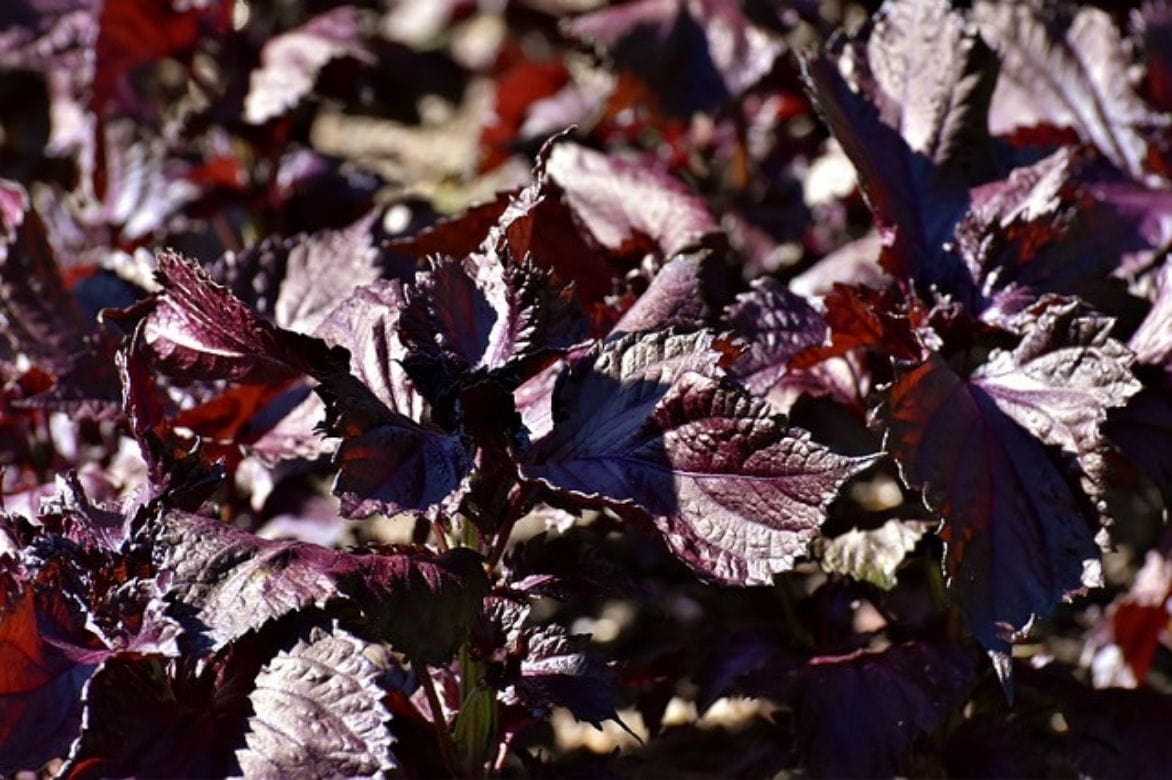
perilla is both an aromatic, culinary, medicinal, and ornamental plant
A member of the mint family, like mint, lemon balm, rosemary, or summer savoury, perilla grows in all soils as long as they are well-drained and cool. It requires a location in full sun or partial shade.
If you are a fan of aromatic plants with a unique taste, Perilla frutescens is sure to delight your taste buds.
Description and botany
Botanical data
- Latin name Perilla frutescens
- Family Lamiaceae
- Common name Nankin perilla, shiso, Japanese basil, Chinese basil, Japanese parsley, wild sesame
- Flowering summer
- Height 40 to 120 cm
- Exposure sun or partial shade
- Soil type well-drained and cool
- Hardiness Not hardy
Aromatic plant native to Southeast Asia, Perilla frutescens grows wild from the foothills of the Himalayas to Myanmar, where it can be slightly invasive. A member of the Lamiaceae family, like most aromatic plants cultivated in Europe such as mint, sage, rosemary, savory, oregano, thyme, and lavender, perilla can be considered a vegetable, aromatic, medicinal, condiment, and ornamental plant.
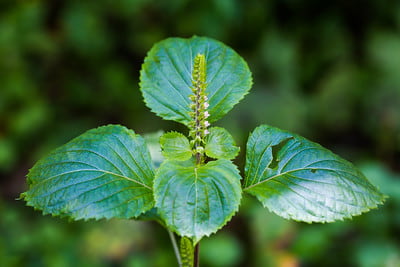
Perilla frutescens
Known and consumed since antiquity by the Chinese, Japanese, Koreans, and Vietnamese, among others for its medicinal virtues, perilla was only introduced to Europe in the late 18th century, primarily for the beauty of its foliage. It was not until the late 20th century that botanists and scientists highlighted its qualities as a dye and allergen neutraliser. It is for this reason that fugu, a highly toxic fish if poorly prepared, is served with a perilla leaf.
In the United States, perilla arrived in the 19th century in the luggage of Asian emigrants who consider it a sacred plant. It has adapted perfectly to the climatic conditions of the country, particularly in the east and southeast, to the point of being considered invasive. Widely used in Shinto medicine in its oil form, perilla is highly regarded for its flavour across all Asian countries. This likely explains the various names attributed to perilla. It serves as a condiment, an herb, a salad ingredient… and is included in the composition of sushi and maki. This plant is found in every family garden from China to Japan, through Bhutan, Korea, Thailand, and India. It is also widely cultivated to produce an oil rich in Omega-3 from its seeds.
Known as “shiso” in Japan and “Su-zi” in China, Perilla frutescens derives from the Latin “perilla,” meaning “sack,” referring to the shape of its flowers, and “frutescens,” meaning “bushy.” It was named by botanist Nathaniel Lord Britton (1859-1934), the first director of the New York Botanical Garden.
Perilla frutescens is a domesticated species of the genus Perilla, which also includes wild species such as Perilla citriodora, Perilla hirtella, and Perilla setoyensis. There are various cultivars and subspecies of Perilla frutescens that differ in leaf colour and flavour.
Perilla is an annual plant with rapid growth and a bushy habit, upright and branched. Depending on the varieties and growing conditions, it measures between 40 and 150 cm. This leafy vegetable has quadrangular stems.
This plant is remarkable for its colourful deciduous foliage. The opposite leaves of perilla are lanceolate, pointed, and serrated. Slightly undulating, they are covered with tiny hairs on the upper side, giving them a velvety appearance. The underside of the leaves features pubescent and prominent veins. Depending on the varieties, the leaf colour ranges from dark green to dark bronze or dark purple.
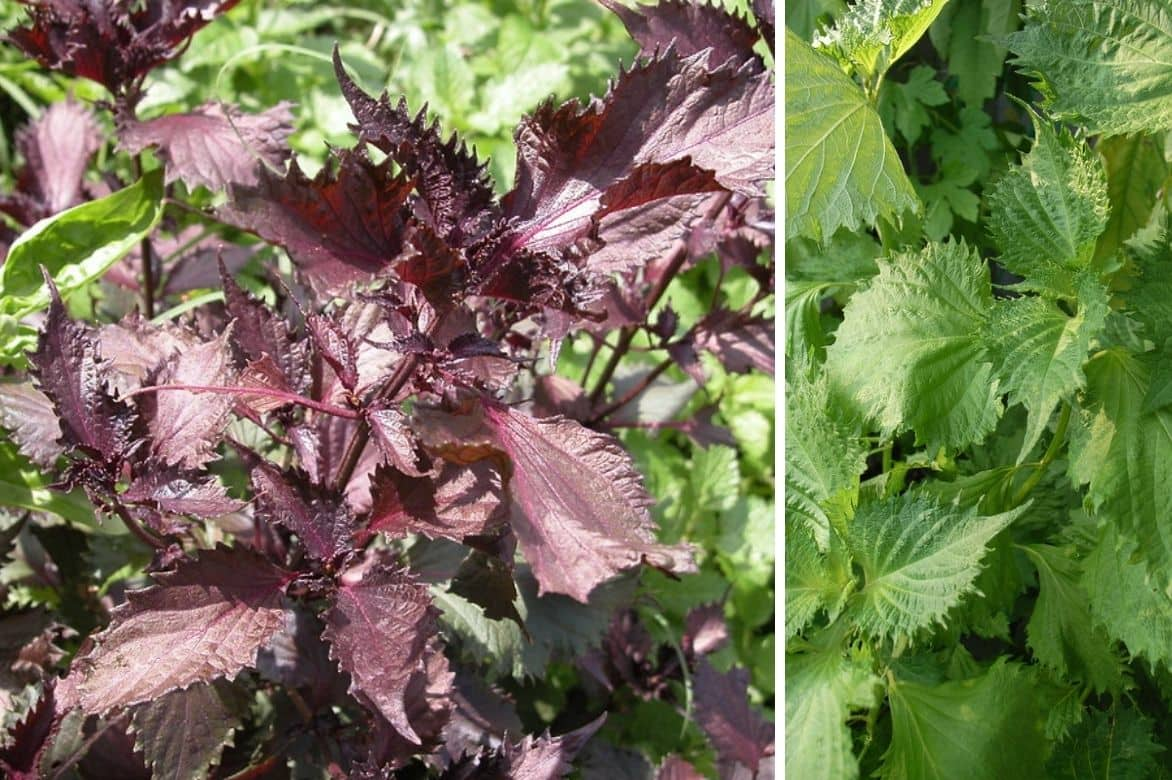
The foliage of perilla varies from green to purplish depending on the varieties
Some are even variegated, making perilla a striking plant in a flowerbed or pot. These leaves emit a pleasant aroma that mixes scents of coriander, cinnamon, and star anise. Each leaf measures between 7 and 15 cm.
Flowers appear at the end of summer. Of little interest, they are tiny and grouped in spikes. These terminal flowers, covered in microscopic white hairs, perched on a hairy peduncle, have a calyx or sack shape that explains their Latin name. They vary in colour, ranging from pinkish white to greenish or purplish red. Highly melliferous, these flowers attract pollinating insects to the garden. They produce small black seeds, rich in essential oil and oilseeds.
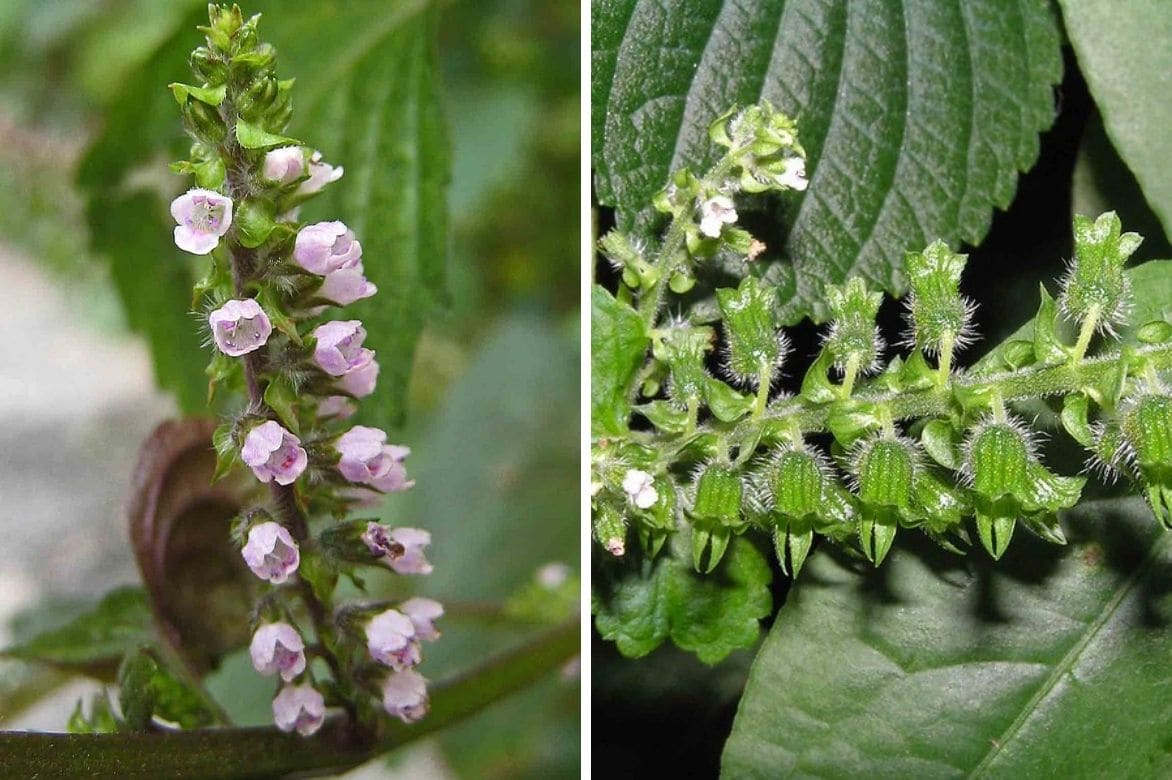
The flowers of perilla are highly melliferous and attract pollinators
Perilla is sensitive to frost and is grown as an annual plant in our regions. It can also be planted indoors.
Read also
7 exotic aromatic plants easy to growThe different varieties of perilla
Perilla frutescens includes several subspecies and cultivars that can be grown here. They are primarily distinguished by the colour of their leaves. Thus, with purple to violet foliage, we find Perilla frutescens var. crispa purpurea or Perilla frutescens var. crispa ‘Aka shiso’. The foliage of Perilla frutescens var. frutescens ‘Egoma’ is green, while that of Perilla frutescens var. crispa ‘Nankinensis’ is violet-green and has large seeds.
Perilla acuta kuko japonensis is sought after for its large anti-allergenic leaves. Meanwhile, Perilla frutescens var. crispa f. crispidisclor produces bicoloured leaves, bright green on top and purple underneath.
Finally, Perilla Magilla is purely decorative, its leaves splashed with magenta pink and green being inedible.
Our favourite Perillas
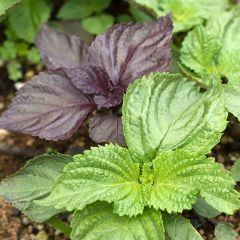
Perilla frutescens vert - Shiso
- Flowering time August to November
- Height at maturity 50 cm
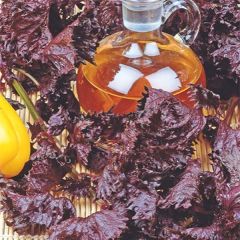
Perilla Rouge - Shiso
- Flowering time August to November
- Height at maturity 50 cm
A Decorative Variety
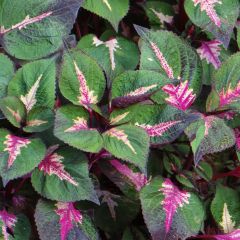
Perilla frutescens 'Magilla Purple'
- Flowering time August, September
- Height at maturity 55 cm
Discover other Perilla seeds
View all →Available in 1 sizes
Available in 1 sizes
Available in 1 sizes
Available in 1 sizes
Available in 1 sizes
Planting Perilla
Where to plant it?
Perilla is not very demanding in terms of soil type. Ordinary soil is suitable as long as it is well-drained and rich in organic matter. The soil should retain some moisture without being too wet or waterlogged.
It prefers a sunny location. Partial shade may be acceptable, but its foliage will be less colourful and vibrant.
When and how to plant it?
Perilla is planted in the garden in spring as soon as the risk of frost has passed. If you wish to sow directly in the ground, you should wait until temperatures reach 18 to 20 °C, in soil enriched with compost. The soil should be kept moist with mulch. Thin out to leave one perilla plant every 30 to 40 cm.
Indoors, you can sow earlier, from late winter, in March or April. Again, the temperature should be 18 to 20 °C for your seeds to germinate. Sow them in pots with a bit of potting soil and place them in the light. The seeds should be barely covered with soil. When the seedlings have 3 to 4 leaves, they can be transplanted into the ground at a spacing of one plant every 30 to 40 cm. You may optionally cover your perilla plants with a cloche to aid their establishment.
How to plant it in a pot?
Perilla grows very well in pots, which must be well-drained with gravel or clay balls. Perilla seeds are sown in potting soil for vegetables. Then, you need to keep the pot at a temperature of 20 °C and maintain some humidity.
When the seedlings have 3 to 4 leaves, transplant them into individual pots, also drained with clay balls and filled with a mix of potting soil and garden soil.
Care and harvest
Perilla requires very little care. However, two actions can help achieve dense young plants and limit proliferation.
On one hand, you will need to pinch the tips of the young shoots to encourage branching and the development of the leaves of the perillas. This will result in denser and bushier foliage. This action should be performed throughout the plant’s development.
Similarly, it is advisable to prune the flower spikes as soon as they appear to limit fruiting. Perilla tends to self-seed easily and abundantly. However, keep a few flowering plants to collect seeds for next spring. The seeds have a limited lifespan of one year.
Watering should be regular to keep the soil moist. Mulching can help space out these waterings while limiting the proliferation of adventive plants.
Perilla is not very susceptible to diseases and pests. Only slugs can attack it. Discover Ingrid’s tips for fighting these enemies effectively and naturally.
When and how to harvest?
The leaves can be harvested as needed from May to October. You can pick the young shoots as well as the flower spikes.
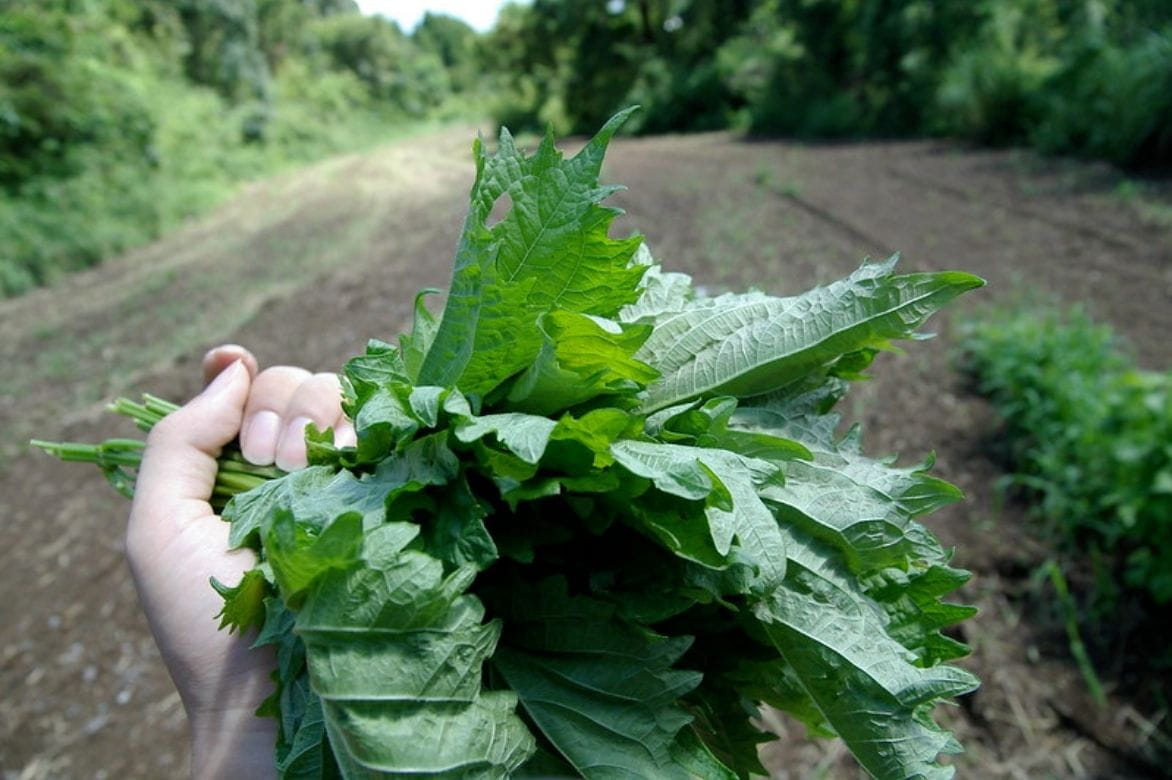
Perilla is harvested as needed
Perilla is consumed immediately. The leaves can also be dried and ground into powder for consumption.
How do we associate it in the garden?
Périlla can be grown in the vegetable garden, but it would be a shame to miss out on the potential of its lovely foliage. Perilla frutescens can easily be integrated into a border, a bed, or a flowerbed as an ornamental plant. Varieties with purple foliage will highlight perennials with light flowers or warmer shades, such as zinnias, dahlias, dianthus, tagetes, rudbeckias, daisies, hardy geraniums, hemerocallis, and more.
Périlla looks stunning alongside ornamental grasses such as pennisetum, stipa, or miscanthus.
You can also create an edible mixed border by pairing preilla with other aromatic plants like sage or mint, along with lavenders, nasturtiums, beetroots, cabbages, and more.
How to cook shiso?
With its herbaceous and tangy flavour, and its purple or green leaves, shiso is worth discovering in culinary terms. As it is an aromatic and condiment plant, it can be used in a myriad of ways, much like basil or mint, its cousins.
Perilla leaves can be enjoyed raw in a salad or with raw vegetables. They will add flavour and colour and pair well with tomatoes, cucumbers, avocado…
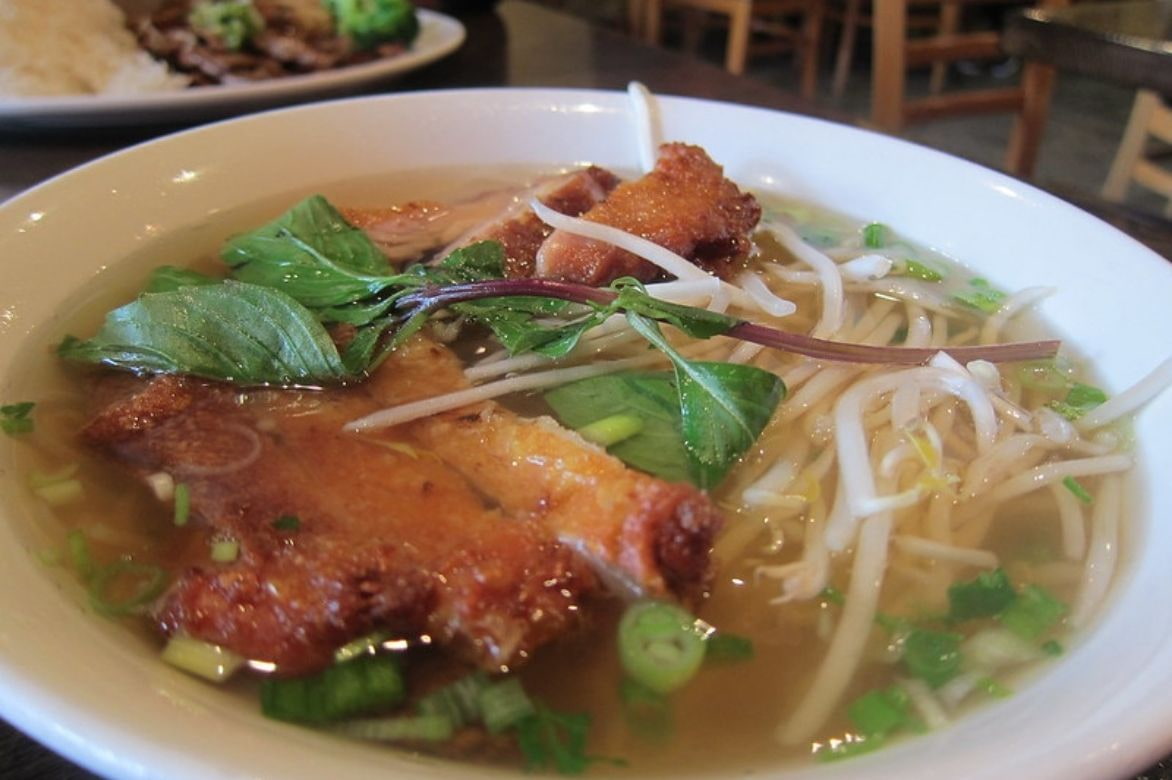
Both the leaves and the flower spikes of perilla are widely used in Asian cuisine
Cooked, they enhance the taste of all fish and seafood, soups, tofu, pasta and rice, as well as chicken or pork. It can easily be incorporated into sushi or sashimi, used to garnish spring rolls, added to a sauce, or made into a pesto. In Japan, perilla leaves are cooked as fritters in the form of tempura. And purple shiso colours umeboshi, salted plums.
- Subscribe!
- Contents































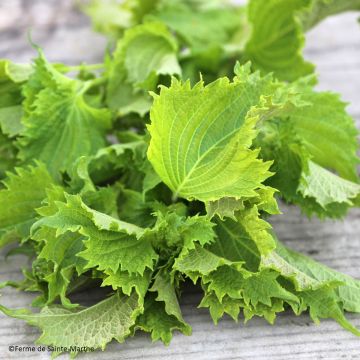


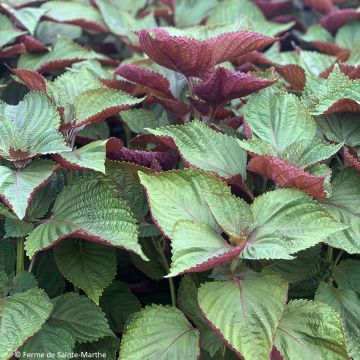
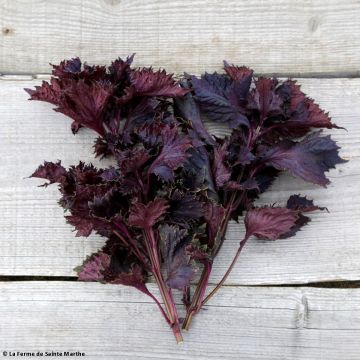
Comments